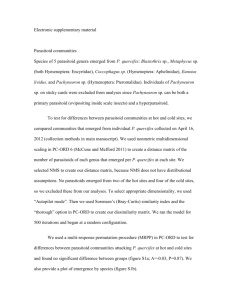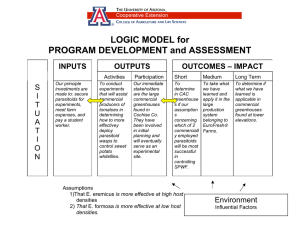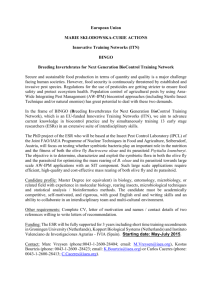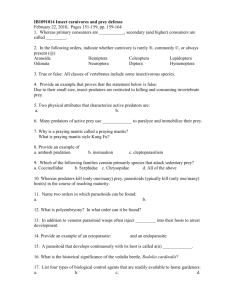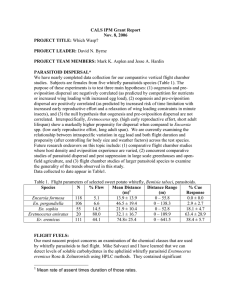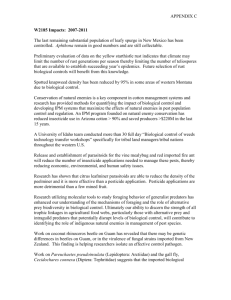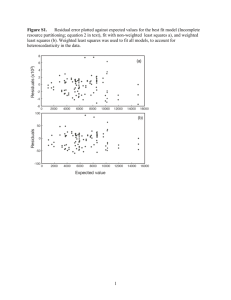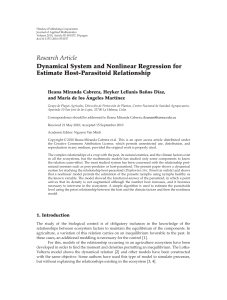PARASITOID INTERACTIONS AND BIOLOGICAL CONTROL N.J. Mills INTRODUCTION
advertisement
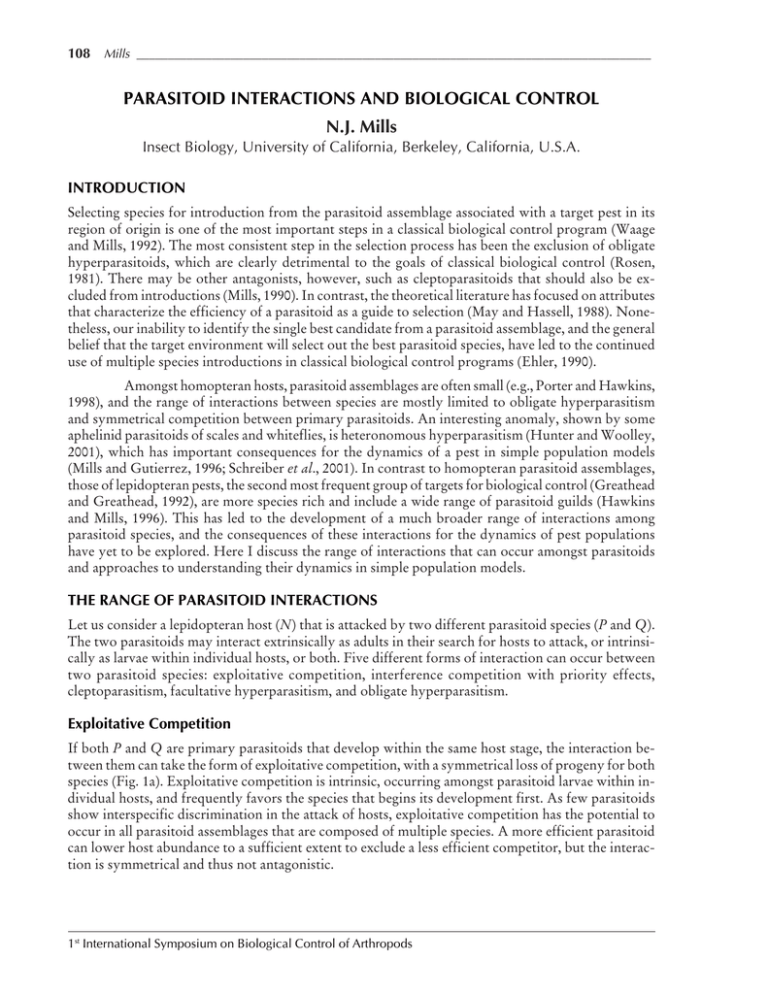
108 Mills __________________________________________________________________________________ PARASITOID INTERACTIONS AND BIOLOGICAL CONTROL N.J. Mills Insect Biology, University of California, Berkeley, California, U.S.A. INTRODUCTION Selecting species for introduction from the parasitoid assemblage associated with a target pest in its region of origin is one of the most important steps in a classical biological control program (Waage and Mills, 1992). The most consistent step in the selection process has been the exclusion of obligate hyperparasitoids, which are clearly detrimental to the goals of classical biological control (Rosen, 1981). There may be other antagonists, however, such as cleptoparasitoids that should also be excluded from introductions (Mills, 1990). In contrast, the theoretical literature has focused on attributes that characterize the efficiency of a parasitoid as a guide to selection (May and Hassell, 1988). Nonetheless, our inability to identify the single best candidate from a parasitoid assemblage, and the general belief that the target environment will select out the best parasitoid species, have led to the continued use of multiple species introductions in classical biological control programs (Ehler, 1990). Amongst homopteran hosts, parasitoid assemblages are often small (e.g., Porter and Hawkins, 1998), and the range of interactions between species are mostly limited to obligate hyperparasitism and symmetrical competition between primary parasitoids. An interesting anomaly, shown by some aphelinid parasitoids of scales and whiteflies, is heteronomous hyperparasitism (Hunter and Woolley, 2001), which has important consequences for the dynamics of a pest in simple population models (Mills and Gutierrez, 1996; Schreiber et al., 2001). In contrast to homopteran parasitoid assemblages, those of lepidopteran pests, the second most frequent group of targets for biological control (Greathead and Greathead, 1992), are more species rich and include a wide range of parasitoid guilds (Hawkins and Mills, 1996). This has led to the development of a much broader range of interactions among parasitoid species, and the consequences of these interactions for the dynamics of pest populations have yet to be explored. Here I discuss the range of interactions that can occur amongst parasitoids and approaches to understanding their dynamics in simple population models. THE RANGE OF PARASITOID INTERACTIONS Let us consider a lepidopteran host (N) that is attacked by two different parasitoid species (P and Q). The two parasitoids may interact extrinsically as adults in their search for hosts to attack, or intrinsically as larvae within individual hosts, or both. Five different forms of interaction can occur between two parasitoid species: exploitative competition, interference competition with priority effects, cleptoparasitism, facultative hyperparasitism, and obligate hyperparasitism. Exploitative Competition If both P and Q are primary parasitoids that develop within the same host stage, the interaction between them can take the form of exploitative competition, with a symmetrical loss of progeny for both species (Fig. 1a). Exploitative competition is intrinsic, occurring amongst parasitoid larvae within individual hosts, and frequently favors the species that begins its development first. As few parasitoids show interspecific discrimination in the attack of hosts, exploitative competition has the potential to occur in all parasitoid assemblages that are composed of multiple species. A more efficient parasitoid can lower host abundance to a sufficient extent to exclude a less efficient competitor, but the interaction is symmetrical and thus not antagonistic. 1st International Symposium on Biological Control of Arthropods ____________________________________________Parasitoid interactions and biological control 109 Interference Competition and Priority Effects When both P and Q are primary parasitoids, interference competition characterizes intrinsic interactions that are asymmetrical with a consistent victor (Q) and victim (P) (Fig. 1b). A competitive advantage can arise due to physical combat, physiological suppression, or shorter developmental time. One of the key outcomes of interference competition is that eggs laid by the victor develop to become reproductive adults, whereas those of the victim are wasted. Ectoparasitoids often have a developmental advantage over endoparasitoids, and it is interesting to note that in this case the victor may gain an added fitness advantage from improved host quality, as shown recently for Hyssopus pallidus (Askew), a gregarious ectoparasitoid of the codling moth (Cydia pomonella [L.]) (Zaviezo and Mills, 2001). Extrinsic interactions between P and Q as primary parasitoids can also lead to consistent asymmetrical competition through priority effects. This typically occurs as an indirect interaction between parasitoids that develop at different stages of the host life cycle, such that an earlier attacking parasitoid (Q) has a distinct advantage of a later attacking species (P) due to the greater number of hosts available (Fig. 1b). Priority effects can also result from direct interactions between adult parasitoids searching for hosts to attack, in that the stronger competitor will drive a weaker species away from a host (e.g., Mills 1991). Extrinsic priority effects differ from intrinsic interference competition and from cleptoparasitism (see below) in that the inferior competitor does not experience wastage of eggs. Cleptoparasitism In a few cases, asymmetrical interactions between parasitoid species can take a rather different form (Fig. 1c). If P is a primary parasitoid and Q a cleptoparasitoid, Q is intrinsically superior to P through larval combat, but P is extrinsically superior to Q in the search for healthy hosts. However, females of Q have a greater rate of success in finding hosts previously attacked by P than healthy hosts due to their ability to respond to oviposition markers left on hosts by P. Even though P is extrinsically superior in its search for healthy hosts, Q selectively finds hosts attacked by P and steals them for its own progeny production. Thus cleptoparasitism is similar to interference competition in that the inferior species wastes eggs, but differs from interference competition in that the attack rate of previously parasitized hosts is greater than that of healthy hosts. Facultative Hyperparasitism If P is a primary parasitoid and Q a facultative hyperparasitoid, then Q can attack both primary hosts, developing as a primary parasitoid, and secondary hosts, developing as a hyperparasitoid (Fig. 1d). Thus facultative hyperparasitism is functionally equivalent to intraguild predation. As idiobionts, facultative hyperparasitoids attack the mature larvae or pupae of primary parasitoids once the latter have killed the primary host, a characteristic often referred to as pseudohyperparasitism. Although primary and secondary hosts may provide very similar cues for host searching, facultative hyperparasitoids can have distinct preferences for one or other host and thus the level of antagonism can be very variable. Obligate Hyperparasitism If P is a primary parasitoid and Q an obligate hyperparasitoid, the interaction between P and Q is purely trophic rather than competitive (Fig. 1e). Obligate hyperparasitism in common amongst almost all parasitoid assemblages with multiple parasitoid species. In contrast to facultative hyperparasitoids, most obligate hyperparasitoids are koinobionts and tend to attack the secondary host (the primary parasitoid) during its larval stage within the living primary host. While some obli- 1st International Symposium on Biological Control of Arthropods 110 Mills __________________________________________________________________________________ a. Exploitative competition b. Interference and priority Q c. Cleptoparasitism Q Q P P N P N Symmetrical, non antagonistic N Intrinsic interference, or extrinsic priority d. Facultative hyperparasitism (intraguild predation) Intrinsic interference, > attack rate on hosts with P e. Obligate hyperparasitism Q P Q P N N Q attacks P as well as shared host N Q attacks P in place of N Figure 1. The range of interactions that can occur between parasitoid species P and Q attacking a shared host N. For the asymmetrical interactions (b-e) parasitoid Q is shown as the interactive antagonist and victor of the interaction. See text for details. gate hyperparasitoids oviposit directly into primary parasitoid larvae within the phytophagous host, others oviposit into a phytophagous host in anticipation of attack by a primary parasitoid or onto surfaces where eggs will be eaten by phytophagous hosts. THE DYNAMIC CONSEQUENCES OF PARASITOID INTERACTIONS The goal of classical biological control is to suppress the abundance of an arthropod pest to a level that is tolerable in the target environment. If multiple parasitoid introductions are necessary, it becomes of vital importance to understand the potential consequences of interactions between the species. For example, would the priority effect of a search-limited early larval parasitoid that is providing partial control prevent a subsequent egg-limited late larval parasitoid from imposing significant additional mortality? Similarly, would the introduction of a larval ectoparasitoid, whose rapid development confers consistent competitive superiority to a partially effective resident larval endoparasitoid, be a detrimental introduction for classical biological control? An understanding of the dynamic consequences of parasitoid interactions should help us to answer these often overlooked yet fundamentally important questions. 1st International Symposium on Biological Control of Arthropods ____________________________________________Parasitoid interactions and biological control 111 In an attempt to resolve these potential dilemmas we use a conceptual discrete-time model to delineate a system with a single pest N, a primary parasitoid P and an interactive parasitoid Q. This interactive model captures all of the antagonistic parasitoid interactions noted above, and is an extension of the well known Nicholson-Bailey model: Nt+1 = λNtg(Nt)fN(Pt)fN(Qt) Pt+1 = cPNλNt[1-fN(Pt)]fP(Qt) Qt+1 = cQNλNt[1-fN(Qt)]fN(Pt)+cQPλNt[1-fN(Pt)][1-fP(Qt)] where λ is the per capita growth rate of the host population, g(Nt) is a density dependent function limiting host population growth, fN (Pt) is the escape response or proportion of individuals of host N that escape attack by the primary parasitoid P, fi (Qt) is the escape of host i from the interactive parasitoid Q, and cij is the number of female parasitoids produced per host j when attacked by parasitoid i. This model is equivalent to that of Hochberg (1996) with the exception of the ordering of host density dependence. Using a Ricker (1954) curve for g(Nt), and an escape function based on aggregated encounters with hosts (May, 1978) and either egg or host limitation (Getz and Mills, 1996) for fi(Jt), we find that obligate hyperparasitism is always detrimental to pest suppression. In contrast, however, the outcome of other forms of interaction is dependent upon the degree of aggregation of encounters between the interactive parasitoid and its host(s), and to a lesser extent on the form of limitation (search or egg) of the primary parasitoid. If both the primary and interactive parasitoids have highly aggregated search (k << 1), then most forms of parasitoid interaction lead to greater suppression of the pest. To illustrate this point (Fig. 2), consider a pest population with a moderate population growth rate (λ = 3) and a carrying capacity (K) of 1,000 individuals. At generation 50 a primary parasitoid (P) is introduced and this parasitoid is egg limited (lifetime fecundity bP = 20), but has a relatively high attack rate (aPN = 0.6) and highly aggregated encounters with hosts (kP = 0.25). Alone, parasitoid P is able to reduce pest abundance from 1,000 to 300 individuals. A second interactive parasitoid (Q) is introduced at generation 100 and this further reduces pest abundance to 20 individuals, despite the parasitoid being less effective in attacking healthy hosts N (aQN = 0.3), highly effective in attacking hosts previous parasitized by P (aQP = 0.8), and free of egg limitation (bQ = 1000). These characteristics would be representative of a cleptoparasitoid or a facultative hyperparasitoid, where in both cases the interactive parasitoid has a greater propensity to attack the primary parasitoid than the pest. From more extensive analysis of this simple interactive model, we find that an interactive parasitoid only becomes detrimental to suppression of the equilibrium abundance of the pest as it approaches becoming an obligate hyperparasitoid (aQN →0), or as the degree of aggregation becomes insufficient to allow stable coexistence of the two parasitoids (kQ →1). From this we might conclude that there is minimal risk in introducing interactive parasitoids in classical biological control programs provided there is evidence of strong aggregation in the pattern of attacks among hosts. However, the coexistence of the primary and interactive parasitoids, and their synergistic action in suppressing host abundance in this simple model, are facilitated by the use of the negative binomial to distribute parasitoid encounters among hosts. As noted by Kakehashi et al. (1984) the use of the negative binomial in multiparasitoid-host models implies an independence of niches with little overlap between the two parasitoids. Niche separation favors stability, and allows even minimal additional attack on the primary host (pest) to outweigh the antagonistic effects of the interactive parasitoid on the abundance of the primary parasitoid. 1st International Symposium on Biological Control of Arthropods 112 Mills __________________________________________________________________________________ N Abundance 1000 P Q 100 10 1 0 50 100 150 Generations Figure 2. A simulation run of the interactive parasitoid model, showing the host population N in the absence of parasitoids (generations 1-50), after the introduction of a primary parasitoid P (generations 51-100), and the subsequent introduction of an interactive parasitoid Q (generations 101150). Model parameters λ = 3, K = 1000, bP = 20, bQ = 1000, ci = 0.5, ki = 0.25, aPN = 0.6, aQN = 0.3, aQP = 0.8. The degree of niche overlap between parasitoid species is generally unknown, but seems unlikely to be as minimal as implied by a negative binomial distribution of parasitoid encounters with hosts. Thus we are currently extending the interactive model, following Kakehashi et al. (1984) and Mills (2001), to determine how variable niche overlap and the presence of a host refuge from parasitism influence the suitability of interactive parasitoids as candidates for introduction in classical biological control. REFERENCES Ehler, L. E. 1990. Introduction strategies in biological control of insects, pp. 111-134. In Mackauer, M., L. E. Ehler, and J. Roland (eds.). Critical Issues in Biological Control. Intercept, Andover, United Kingdom. Getz, W. M. and N. J. Mills. 1996. Host-parasitoid coexistence and egg-limited encounter rates. American Naturalist 148: 301-315. Greathead, D. J. and A. Greathead. 1992. Biological control of insect pests by insect parasitoids and predators: the BIOCAT database. Biocontrol News and Information 13: 61N-68N. Hawkins, B. A. and N. J. Mills. 1996. Variability in parasitoid community structure. Journal of Animal Ecology 65: 501-516. Hochberg, M. E. 1996. Consequences for host population levels of increasing natural enemy species richness in biological control. American Naturalist 147: 307-318. Hunter, M. S. and J. B. Woolley. 2001. Evolution and behavioral ecology of heteronomous aphelinid parasitoids. Annual Review of Entomology 46: 251-290. Kakehashi, N., Y. Suzuki, and Y. Iwasa. 1984. Niche overlap of parasitoids in host-parasitoid systems: its consequence to single versus multiple introduction controversy in biological control. Journal of Applied Ecology 21: 115-131. 1st International Symposium on Biological Control of Arthropods ____________________________________________Parasitoid interactions and biological control 113 May, R. M. 1978. Host-parasitoid systems in patchy environments: a phenomenological model. Journal of Animal Ecology 47: 833-844. May, R. M. and M. P. Hassell. 1988. Population dynamics and biological control. Philosophical Transactions of the Royal Society of London, Series B, 318: 129-169. Mills, N. J. 1990. Biological control, a century of pest management. Bulletin of Entomological Research 80: 359-362. Mills, N. J. 1991. Searching strategies of the parasitoids of the ash bark beetle (Leperisinus varius F.) and its relevance to biological control. Ecological Entomology 16: 461-470. Mills, N. J. 2001. Factors influencing top-down control of insect pest populations in biological control systems. Basic and Applied Ecology 2: 323-332. Mills, N. J. and A. P. Gutierrez. 1996. Prospective modelling in biological control: an analysis of the dynamics of heteronomous hyperparasitism in a cotton-whitefly-parasitoid system. Journal of Applied Ecology 33: 1379-1394. Porter, E. E. and B. A. Hawkins. 1998. Patterns of diversity for aphidiine (Hymenoptera: Braconidae) parasitoid assemblages on aphids (Homoptera). Oecologia 116: 234-242. Ricker, W. E. 1954. Stock and recruitment. Journal of the Fisheries Research Board of Canada 11: 559-623. Rosen, D. 1981. The Role of Hyperparasitism in Biological Control: A Symposium. Division of Agricultural Sciences, University of California, Berkeley, California, U.S.A. Schreiber, S. J., N. J. Mills, and A. P. Gutierrez. 2001. Host-limited dynamics of autoparasitoids. Journal of Theoretical Biology 212: 141-153. Waage, J. K. and N. J. Mills. 1992. Biological control, pp. 412-430. In Crawley, M. J. (ed.). Natural Enemies: the Population Biology of Predators, Parasites and Diseases. Blackwell, Oxford, United Kingdom. Zaviezo, T. and N. J. Mills. 2001. The response of Hyssopus pallidus to hosts previously parasitized by Ascogaster quadridentata: heterospecific discrimination and host quality. Ecological Entomology 26: 91-99. 1st International Symposium on Biological Control of Arthropods
